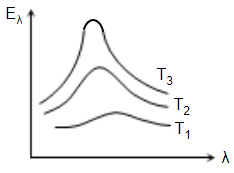The figure shows a system of two concentric spheres of radii \(r_1\) and \(r_2\) and kept at temperatures \(T_1\) and \(T_2,\) respectively. The radial rate of flow of heat in a substance between the two concentric spheres is proportional to:

1. \(\frac{r_1r_2}{r_1-r_2}\)
2. \(r_1-r_2\)
3. \(({r_1-r_2})({r_1r_2})\)
4. \(\mathrm{ln}\frac{r_2}{r_1}\)

1. \(\frac{r_1r_2}{r_1-r_2}\)
2. \(r_1-r_2\)
3. \(({r_1-r_2})({r_1r_2})\)
4. \(\mathrm{ln}\frac{r_2}{r_1}\)
The graph shown in the adjacent diagram, represents the variation of temperature (T) of two bodies, x and y having same surface area, with time (t) due to the emission of radiation. Find the correct relation between the emissivity (e) and absorptivity (a) of the two bodies .
(1)
(2)
(3)
(4)
The plots of intensity versus wavelength for three black bodies at temperatures \(T_1, T_2 ~\text{and}~T_3\) respectively are as shown. Their temperature are such that:
1. \(T_1>T_2>T_3\)
2. \(T_1>T_3>T_2\)
3. \(T_2>T_3>T_1\)
4. \(T_3>T_2>T_1\)
The adjoining diagram shows the spectral energy density distribution \(E_{\lambda}\) of a black body at two different temperatures. If the areas under the curves are in the ratio \(16:1,\) the value of temperature \(T\) is:

1. \(32000~\text K\)
2. \(16000~\text K\)
3. \(8000~\text K\)
4. \(4000~\text K\)
Following graph shows the correct variation in intensity of heat radiations by black body and frequency at a fixed temperature
Variation of radiant energy emitted by sun, filament of tungsten lamp and welding arc as a function of its wavelength is shown in figure. Which of the following option is the correct match?

(1) Sun-, tungsten filament- welding arc -
(2) Sun-, tungsten filament-, welding arc-
(3) Sun-, tungsten filament- welding arc-
(4) Sun-, tungsten filament-, welding arc-
Shown below are the black body radiation curves at temperatures and (>). Which of the following plots is correct ?
The spectrum of a black body at two temperatures 27 and 327 is shown in the figure. Let and be the areas under the two curves respectively. The value of is
(a) 1 : 16
(b) 4 : 1
(c) 2 : 1
(d) 16 : 1
A block of metal is heated to a temperature much higher than the room temperature and allowed to cool in a room free from air currents. Which of the following curves correctly represents the rate of cooling?
| 1. |  |
2. |  |
| 3. |  |
4. |  |
The energy distribution E with the wavelength for the black body radiation at temperature T Kelvin is shown in the figure. As the temperature is increased the maxima will:
| 1. | Shift towards left and become higher |
| 2. | Rise high but will not shift |
| 3. | Shift towards right and become higher |
| 4. | Shift towards left and the curve will become broader |












